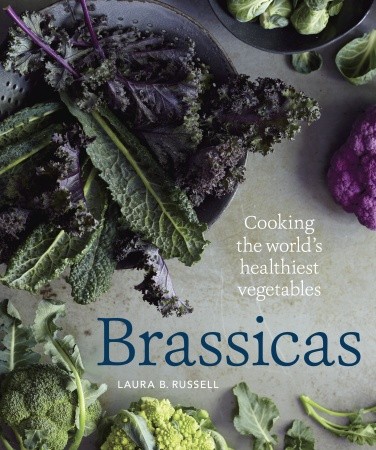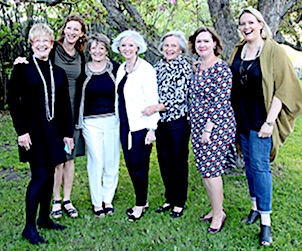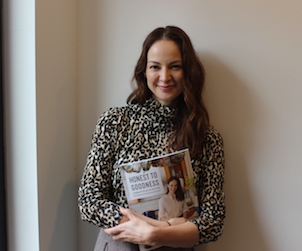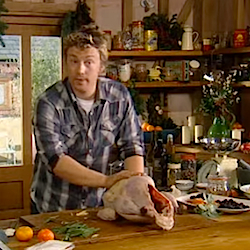
In a recent piece called ‘Good Greens‘ Jane Kramer writes in The New Yorker about the new “kind of vegetarian” cookbooks. Kramer identifies a trend: collections of recipes that are mostly about cooking vegetables, but sometimes also include animal things. They are about vegetables seasoned with meat, following the advice of plant loving carnivores like Michael Pollan and Mark Bittman. Laura B. Russell’s Brassicas: Cooking The World’s Healthiest Vegetables is very much on that trend, and it’s remarkable that the Brassica family, which famously or infamously (depending on your point of view) includes kale, hasn’t garnered a cookbook of its very own until Russell wrote this one. Here is a brassicas cookbook that deals with the entire library of dark leafy things from radishes to turnips to kohlrabi to cauliflower, in other words what people in the Northern Hemisphere eat for vegetables from November to April (or at least used to, and by locavorish standards ought to).
 Russell is the former cookbooks editor for Food & Wine and a well known food writer around her home in Portland, particularly around gluten-free circles: her previous book is The Gluten-Free Asian Kitchen. On the phone from her Oregon home, Russell explained to me that the she decided to write about brassicas because they were both some of her personal favourite vegetables, and some of the least popular ones at large. “I just felt like they’re are still a lot of haters,” she said laughing, adding “you know there are still a lot of people who will tell you that they don’t like these vegetables, but I really believe it’s just because they don’t now how to cook them properly.”
Russell is the former cookbooks editor for Food & Wine and a well known food writer around her home in Portland, particularly around gluten-free circles: her previous book is The Gluten-Free Asian Kitchen. On the phone from her Oregon home, Russell explained to me that the she decided to write about brassicas because they were both some of her personal favourite vegetables, and some of the least popular ones at large. “I just felt like they’re are still a lot of haters,” she said laughing, adding “you know there are still a lot of people who will tell you that they don’t like these vegetables, but I really believe it’s just because they don’t now how to cook them properly.”
Brassicas is a pretty book full of green and purple hues from the colour photography of Sang Ann. It divides into seven chapters covering what she sees as the main groupings for the various members of the cabbage family: 1) Kale; 2) Cauliflower; 3) Brussels Sprouts and Cabbage; 4) Broccoli; 5) Leafy Brassicas (Collard Greens, Mustard Greens, Broccoli Rabe (or Rapini), Arugula and Cress); 6) Asian Brassicas (Bok Choy, Chinese Broccoli (or Gai Lan), Mizuna, Napa Cabbage and Tatsoi); and 7) Root Brassicas (Radish, Turnip, Rutabaga, Horseradish and Wasabi) and Kohlrabi. The range of recipes is as extensive as the array of ingredients. There salads, stews, soups, roasts, things with sauces: the whole gamut. And since the vegetables are from the same family, there is an underlying assumption that many recipes could be interchanged between a particular brassica.
In every page the vegetable is the star, whether the recipe is vegetarian or not or designed mostly as a main or a side dish. Russell thinks her book is part of a growing home cooking trend (I asked her about Kramer’s article) that’s come about by the increasing attention vegetables are getting from professional chefs. In Portland, she said the concept of a “vegetable section” of a restaurant menu is growing. And, then there’s the health issue. Brassicas’ introduction is written by healthy eating advocate and author Rebecca Katz. Every ingredient section includes information on the nutritional benefits of the focus of the dish. Only a week or so on the market, and Russell reports that the book is being well received. As North American diets move increasingly towards the dark, leafy and green, it seems very likely that Brassicas will become a classic reference book and a marker of when peoples’ eating habits really began to change.
 Malcolm Jolley is a founding editor of Good Food Revolution and Executive Director of Good Food Media, the company that publishes it. Follow him at @malcolmjolley.
Malcolm Jolley is a founding editor of Good Food Revolution and Executive Director of Good Food Media, the company that publishes it. Follow him at @malcolmjolley.








…and the plural form is???
O tempora o mores! Point taken, Dean. But I actually think the s works in the sense that Russell is writing about distinct groups within the family brassica. A bit like adding the s to people, ie the peoples of North America.
Then she needed to call the book “The Brassicas”, with the definite article.